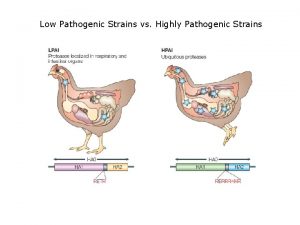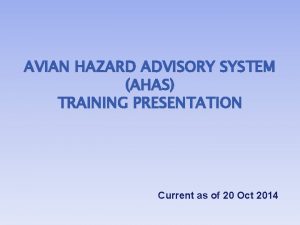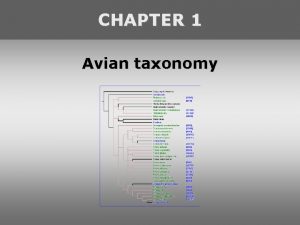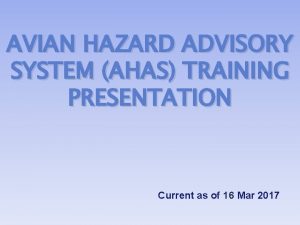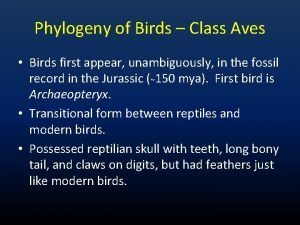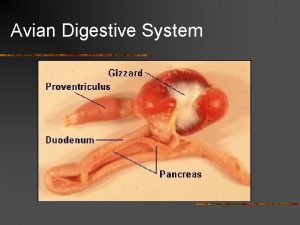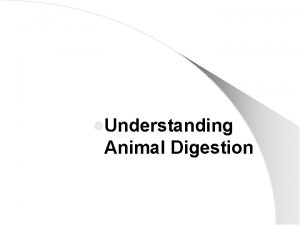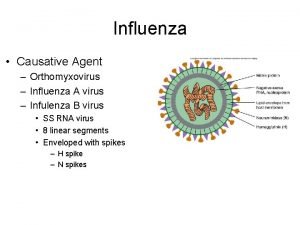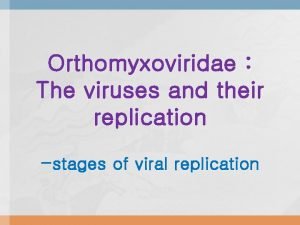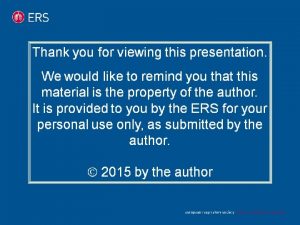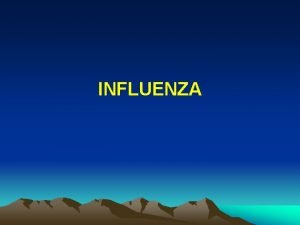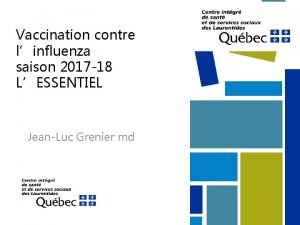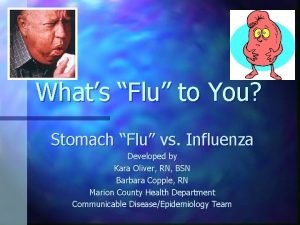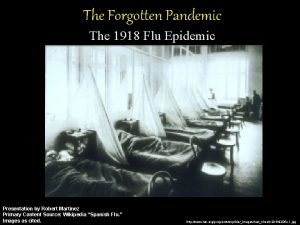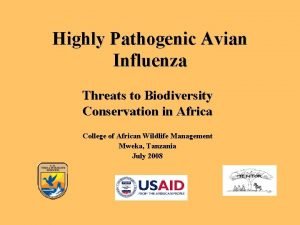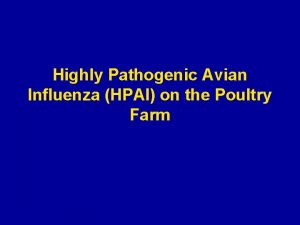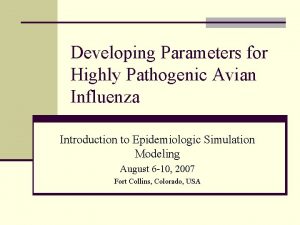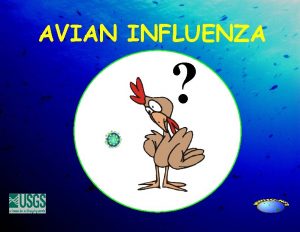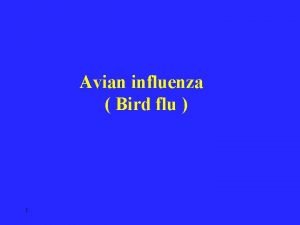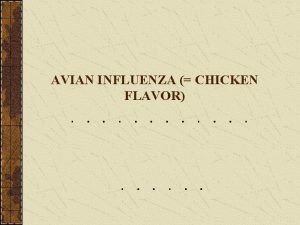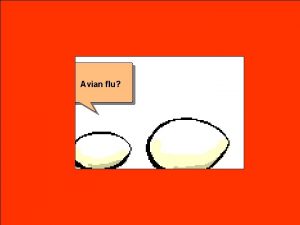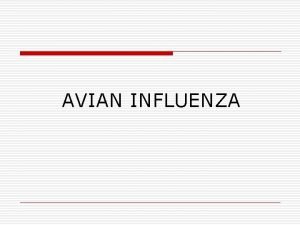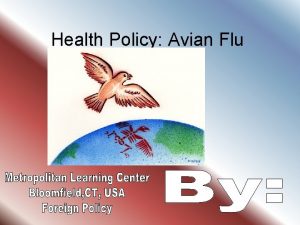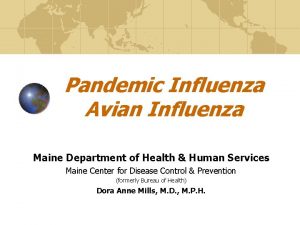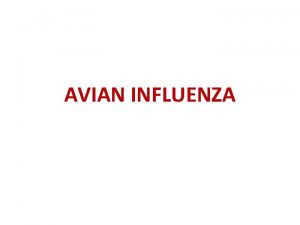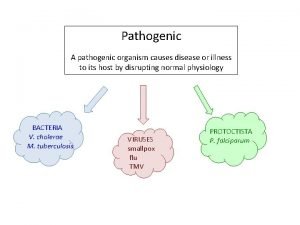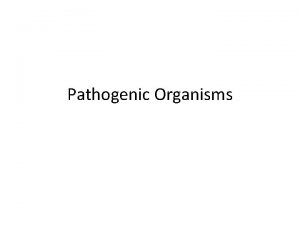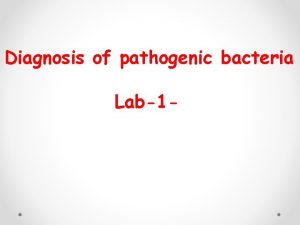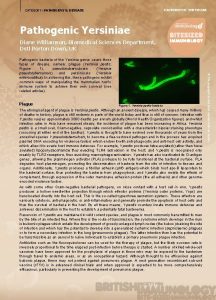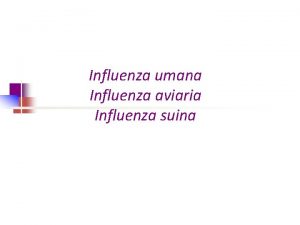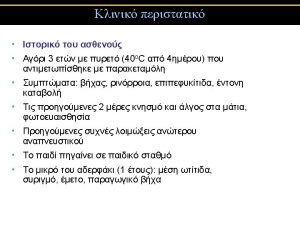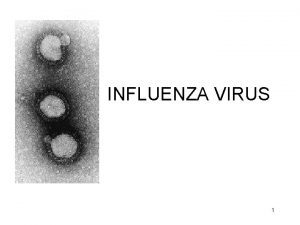Update Highly Pathogenic Avian Influenza in the United























































- Slides: 55

Update Highly Pathogenic Avian Influenza in the United States Dr. Lee Ann Thomas Director, Avian, Swine, and Aquatic Animal Health Center (ASAAHC) U. S. Department of Agriculture Animal and Plant Health Inspection Service Veterinary Services Secretary’s Advisory Committee on Animal Health - January 27, 2015

Outline • Canadian Situation • US Situation • Response Activities • Diagnostics • Wild Bird Surveillance 2

Harbinger of HPAI in the US – Canadian Situation • Outbreak of H 5 N 2 in British Columbia – December 1, 2014 - CFIA placed quarantine on 2 premises (turkey and a broiler breeder farms) breeder broiler farm located in Abbotsford and Chilliwack, BC – 11 commercial (7 broiler breeders, 3 turkey growers, 1 table egg layer) and 2 noncommercial – Total of 245, 780 birds depopulated – March 25, 2015 all quarantines released

Harbinger of HPAI in the US – Canadian Situation Outbreak of H 5 N 2 in British Columbia − Control measures included: o Quarantine of infected premises o Dead bird surveillance - within restricted zone o Flock Health Survey – within restricted zone o Permitting process o Destruction – use of Response Teams o Compost in house and C/D- contracted to 3 rd party o Strict biosecurity measures - zones, signage, guards o Outreach-industry, backyard, wildlife, public messages o Industry Integration in permitting, surveillance, outreach

CFIA’s British Columbia Primary Control Zone

British Columbia Restricted Zone and Infected Zones

Second Outbreak of H 5 N 2 - Ontario − April 6 – CFIA place quarantine on 2 premises (1 turkey and neighboring farm) in Oxford County − April 8 – CFIA confirms H 5 N 2 − To date – 3 premises (2 turkey, 1 broiler breeder) - Last premises detected on April 23

CFIA’s Ontario Control Zones 8

The US Situation WA, Dec 2014 Wild bird mortality event Captive gyrfalcon mortality • Area known to have issues with aspergillosis and lead toxicity • EA/AM H 5 N 2 detected in bird with signs consistent with aspergillosis • Highly similar to virus in Canada • Captive falcon captured and partially consumed wild American wigeon • Remains fed to other gyrfalcons; death of first two falcons within 2 days • EA H 5 N 8 detected Ip HS, et al. Novel Eurasian highly pathogenic influenza A H 5 viruses in wild birds, Washington, USA, 2014. Emerg Infect Dis. 2015 May 2015 http: //dx. doi. org/10. 3201/eid 2105. 142020

United States – Western Front State County Flock Type Species Avian Influenza Confirmation Sub-type Date OR Douglas Backyard Mixed poultry EA-H 5 N 8 Dec. 19, 2014 WA Benton Backyard Mixed poultry EA/AM-H 5 N 2 Jan 3, 2015 WA Benton Backyard Mixed poultry EA/AM-H 5 N 2 Jan 9, 2015 WA Callum Backyard Mixed poultry EA/AM-H 5 N 2 Jan 16, 2015 OR Canyon Backyard Mixed poultry EA/AM-H 5 N 2 Jan 16, 2015 CA Stanislaus Commercial Turkeys EA-H 5 N 8 Jan 23, 2015 WA Okanagon Backyard Game Bird EA/AM-H 5 N 2 Jan 29, 2015 WA Okanagon Backyard Chicken EA/AM-H 5 N 2 Feb 3, 2015 CA Kings Commercial Chicken EA-H 5 N 8 Feb 12, 2015 OR Deschutes Backyard EA/AM-H 5 N 2 Feb 17, 2015 CA Merced Commercial Chicken/duck H 7 N 3 LPAI March 12, 2015 MT Judith Basin Backyard Mixed poultry Chicken EA/AM-H 5 N 2 April 12, 2015

HPAI Outbreak 2014 -2015 Epidemiological Information DRAFT v 2 4. 2015 Figure 1. Premises Detected for ALL STATES 12/10/14 to 4/23/15 Captive Wild, Backyard, Commercial 1 a. Weekly 33 35 30 25 19 20 15 9 10 5 0 1 1 1 2 2 1 2 1 3 Commercial Captive Wild Backyard Earliest available date indicating clinical signs is used for figure. For most premises, this is a suspect or a presumptive positive status. A few premises may only have a confirmed positive status date. Only full weeks (7 days) are pictured; to-date, 4 premises have been detected between 4/22 - 4/23. All data are from EMRS (date that premises was given a status). o 85 premises (3 captive wild bird; 12 backyard flocks; 70 commercial flocks). o This represents 60% of the wild bird detections, 100% of the backyard flock detections, and 95% of the commercial flocks. 1 1

Figure 3. Premises Detected for ALL STATES Including WILD BIRD detections from 12/8/2015 to 4/23/2015 3 a. Weekly 35 31 Wild Bird Detections in the Pacific Flyway 30 First Detection in Commercial Minnesota Flock 25 15 12 10 5 First Detection in a Commercial Flock in California 19 20 18 Wild Bird Detections in the Central/Mississippi Flyways 12 7 3 3 4 1 1 2 1 1 3 3 5 2 2 Wild Bird Commercial Captive Wild Backyard 0 Earliest available date indicating clinical signs is used for figure. For most premises, this is a suspect or a presumptive positive status. A few premises may only have a confirmed positive status date. Only full weeks (7 days) are pictured; to-date, 12 premises have been detected between 4/20 - 4/23. 142 detections (3 captive wild bird; 12 backyard flocks; 70 commercial flocks; 57 wild birds). o All captive bird, backyard flock, and commercial flock data are from EMRS (date that premises was given a status). o Wild bird dates are based on date of collection, from USDA/USGS/National Flyway Council data. o This represents 60% of the wild bird detections, 100% of the backyard flock detections, and 95% of the commercial flocks. 1 2

HPAI in the US (as of April 27, 2015) • Total number of positive premises: 89 – 77 commercial (MN-54, SD-6, CA-3, WI-4, IA-4, MO-2, ND 2, KS-1, AR-1) – 12 backyard (3 OR, 5 WA, 1 MT, 1 MN, 1 WI, 1 KS); • Commercial depopulation or pending depopulation: – Turkeys: approx. 4 million – Chickens: approx. 6. 8 million – Ducks: 35, 600 • Indemnity: $62, 317, 000 • Fourteen H 5 presumptive positive cases are pending NVSL testing (11 turkey premises-MN and 3 commercial layers in IA) • Detections are reported to the OIE 13

HPAI in the US (as of April 27, 2015) Trade impacts: • At least 30 countries have placed restrictions on U. S. poultry exports – Some countries, including South Korea, South Africa, Thailand, and China have imposed bans that cover the entire United States. – Other countries, such as Canada, Japan, Singapore, and the European Union, have limited restrictions to defined regions in the State where a finding occurred. – USDA is actively working with trading partners, the poultry industry, trade associations, and other stakeholders to reduce or eliminate unjustified trade restrictions and mitigate the impact of these detections on exports. 14

EA/AM H 5 N 2 pheasant Okanogan Co, WA Courtesy of L. Badcoe, WSDA EA/AM H 5 N 2 chicken Clallam Co, WA Courtesy of R. Crespo, WADDL 2015 Clallam Co, WA depopulation Courtesy of L. Badcoe, WSDA

Figure 1: USDA APHIS HPAI MAC, ICG and IMT Overview 4. 15 APHIS Off-scene Policy and Incident Coordination APHIS Administrator & AMT Emergency Management Leadership Council VS Deputy Administrator & VS Executive Team APHIS Incident Coordination Group District Directors APHIS Emergency Operations Center (AEOC) (HQ) Support and coordination Assistant Director Public Information Officer Incident Commander & Unified Incident Management Team SAHO Safety Officer Liaison Officer Planning Section Chief Operations Section Chief Finance/Admin Section Chief Logistics Section Chief Requests and information

Figure 2: USDA APHIS HPAI MAC, ICG & IMT Details 4. 15 USDA Off-Scene Policy and Incident Coordination USDA Secretary Industry Associations APHIS AMT NASAHO & NASDA APHIS - MAC Resources APHIS EMLC Public Health Agencies VS - MAC Policy VS Executive Team • • • APHIS HPAI Incident Coordination Group Coordination with Districts and States Support Field Operations Analysis and Reports Other External Partners Multiagency Coordination - Provides Policy, Resources, and Coordination Incident Management – Requests Resources, Coordination and Policy VS Type III IMTs - Green, Gold, Blue, Red IMTs may also serve as Area Command Teams When Needed PPQ has four IMTs. Forest Service has IMTs. District 1 Command ME, NH, VT, MA, CT, RI, NY, NJ, PA, DE, MD, DC, WV, VA, NC District 2 Command District 3 Command District 4 Command District 5 Command TN, SC, GA, AL, FL, PR, VI MN, WI, MI, IA, IL, IN, OH, KY MO, OK, AR, MI, LA, TX MT, ND, SD, ID, WY, NE, KS District 6 Command WA, OR, CA, NV, UT, CO, AZ, NM, AK, HI


United States – Response Activities Ø Quarantine - State issued Ø Zoning: Ø Infected Zone: Minimum 3 km radius of the infected premises Ø Buffer Zone: The area between 3 km and 10 km of the infected premises will be considered the buffer zone. Ø Control Zone: Infected and buffer zone Ø Surveillance Zone: Ø Movement controls and permitting Ø Depopulation/Disposal – C 02 or foam/Incineration, composting, or landfill Ø Indemnity Ø Cleaning and disposal – can be contracted out Ø Strict biosecurity measures Ø Outreach- to community backyard poultry owners, public messages

United States – Response Activities Zones and Areas Premises Infected Zone + Surveillance Zone Buffer Zone = Control Area + = Free Area

United States – Response Activities Ø Quarantine - State issued Ø Zoning: Ø Infected Zone: Minimum 3 km radius of the infected premises Ø Buffer Zone: The area between 3 km and 10 km of the infected premises will be considered the buffer zone. Ø Control Zone: Infected and buffer zone Ø Surveillance Zone: Ø Movement controls and “permitting” Ø Depopulation/Disposal – C 02 or foam/Incineration, composting, or landfill Ø Indemnity Ø Cleaning and disposal – can be contracted out Ø Strict biosecurity measures Ø Outreach- to community backyard poultry owners, public messages

Surveillance Activities - Definitions • Contact Premises (CP): Premises with susceptible animals that may have been exposed to the FAD, either directly or indirectly • Suspect Premises (SP): Premises under investigation due to the presence of susceptible animals reported to have clinical signs compatible with the FAD. • At-Risk Premises (ARP): Premises that have susceptible animals, but none of those susceptible animals have clinical signs compatible with the FAD. 22

Surveillance Activities - Definitions • Monitored Premises (MP): Premises objectively demonstrates that it is not an Infected Premises, Contact Premises, or Suspect Premises. Monitored Premises meet a set of defined criteria in seeking to move susceptible animals or products out of the Control Area by permit. 23

Surveillance Activities – Sampling Schedules for Commercial Premise Contact Premises (CP), Suspect Premises (SP), and Monitored Premises (MP) Collect swabs for the 5 -bird pool sample(s) on each premises every other day for 14 days. At Risk Premises Collect swabs for the 5 -bird pool(s) on each premises once every 5 -7 days for the duration of the quarantine. Continues until the control zone is released. 24

Surveillance – Movement Testing for Commercial Premises Live Animals & Hatching Eggs • Frequency of sampling: Two negative 5 -bird pooled samples are required (r. RT-PCR) prior to movement. Product (Table Eggs) • Frequency of sampling: One negative 5 -bird pooled samples is required (r. RT-PCR) prior to movement. If product is moving every day, sampling should occur every other day. • Timing of sampling: One sample must be taken (with negative test result) within 24 hours of movement. 25

Surveillance – Movement Testing for Commercial Premises Live Animals & Hatching Eggs • Frequency of sampling: Two negative 5 -bird pooled samples are required (r. RT-PCR) prior to movement. Product (Table Eggs) • Frequency of sampling: One negative 5 -bird pooled samples is required (r. RT-PCR) prior to movement. If product is moving every day, sampling should occur every other day. • Timing of sampling: One sample must be taken (with negative test result) within 24 hours of movement. 26

Timelines for Composting • Inside composting: – Compost pile set and outside areas C/Dd • Temperature monitoring • Compost pile turned no sooner that 14 days – 30 days later • Remove compost pile to the outside • C/D inside areas • Environmental sampling – 21 days later • Quarantine release • Disposal of composted materials 27

Timelines for Composting • Outside composting: 30 days after setting compost piles, cleaning and disinfection of all areas on the premises, and negative environmental testing, the quarantine would be released, the owner responsible for disposition of compost, and the premises could be restocked. • Burial: 21 days after cleaning/disinfection of all areas on the premises and negative environmental testing, the quarantine would be and the premises could be restocked. 28

Continuity of Business – Also known as managed movement • Allows movement of non-infected animals and noncontaminated animal products from non-infected premises during an FAD outbreak. • Helps agriculture and food industries to maintain normal business operations but mitigates the risks of animal and product movements. • The “Secure Food Supply Plans” – Secure Egg Supply, Secure Turkey Supply FAD PRe. P/NAHEMS Guidelines: Continuity of Business- Overview USDA APHIS and CFSPH

Wild Bird Surveillance - North American Flyways Courtesy – Dr. Tom Deliberto – USDA-WS 30

Enhanced Pacific Flyway Surveillance • Hunter Harvest • Anseriformes • Where birds were located • Morbidity/Mortality

Enhanced Pacific Flyway Surveillance § Three HPAI viruses detected § § Eurasian H 5 N 8 Mix origin H 5 N 2 and H 5 N 1 § Found most commonly in asymptomatic dabbling ducks § Mortality in raptors

Central and Mississippi Flyway • Currently, limited wild bird surveillance – October – February: ≈ 400 in each flyway – Sampling around poultry cases • MN • MO/AR – Morbidity/Mortality • • Wyoming – Wild Canada Goose MO – Captive Raptors KS – Wild Canada Goose MT – Captive Raptors

Central and Mississippi Flyway

Central and Mississippi Flyways • How are these viruses spreading to new areas (Flyways)? – Most likely through wild birds • Timing and pattern in Pacific Flyway

Central and Mississippi Flyways • How can we explain the series of detections in commercial turkey flocks? – Currently unknown – Not likely direct introductions by wild birds – Virus(es) likely entered flyways during fall migration – Several epidemiological studies underway

Central and Mississippi Flyways • Why are we only seeing cases now? – Not sure but possibly: • Persistence in environment/wild birds – MN: environment – MO/AR: birds • Breeches in biosecurity

Future Plans for Wild Bird Surveillance § Identify distribution across U. S. § Detect early spread into new flyways/regions § Provide flexible surveillance framework that can monitor wild waterfowl populations for: − Re-assortments of influenzas − Introductions of new viruses − Estimate prevalence of important influenzas once detected in an area of concern

Future Plans for Surveillance § Sampling § Passive (morbidity/mortality) § Year round § Active (apparently healthy birds) § In post nesting season (summer) § Fall/Winter Migration Season § Environmental Fecal § Targeted year round

NAHLN Laboratories for AI/ND Puyallup Pullman Fargo Corvallis Bozeman Brookings Logan Storrs Madison Laramie Davis Ithaca St. Paul Lincoln Ames Ft. Collins Manhattan Kennett Square West Reynoldsburg. Harrisburg Urbana. Lafayette Moorefield Columbia Harrisburg Lexington Springfield Hopkinsville Nashville Oakwood Athens Amarillo Center College Station Gonzales Lansing Galesburg Stillwater Tucson University Park Pearl Auburn Raleigh Columbia Tifton Baton Rouge Kissimmee Pearl City AI/ND Approved Laboratory AI Approved Laboratory NVSL Lab Site March 2014 Ewing Georgetown Newark Frederick Salisbury

Current Diagnostics Molecular / Sequencing • Both Screening and confirmation uses • flu. A, H 5, H 7, developmental assays targeting H 5 2. 3. 4. 4 • Subtying samples direct using Sanger sequencing Virus isolation • In vivo pathotyping • Antigenic and whole genome characterization Serologic assays • flu. A, subtype specific – antigenic diversity Pen-side tests • Screening test for clinically ill/dead birds – requires confirmation 2015

EA-H 5* reassortants in North America (AM) *All H 5 2. 3. 4. 4 viruses to date are considered highly pathogenic in poultry 2015

Questions? ?

1 b. Three-Day Interval 20 18 18 16 14 12 9 12 10 7 8 3 4 0 7 Commercial Captive Wild 6 2 8 2 1 1 1 1 2 2 Backyard 2 1 1 1 Earliest available date indicating clinical signs is used for figure. For most premises, this is a suspect or a presumptive positive status. A few premises may only have a confirmed positive status date. All data are from EMRS (date that premises was given a status). o 85 premises (3 captive wild bird; 12 backyard flocks; 70 commercial flocks). o This represents 60% of the wild bird detections, 100% of the backyard flock detections, and 95% of the commercial flocks. 4 4

Figure 2. Premises Detected for MN from 3/4/15 to 4/23/15 2 a. Weekly 35 29 30 25 20 14 15 Backyard 10 5 Commercial 6 3 1 0 2/25/2015 3/3/2015 3/4/2015 3/10/2015 3/11/2015 3/17/2015 3/18/2015 3/24/2015 3/25/2015 3/31/2015 4/7/2015 4/8/2015 4/14/2015 4/15/2015 4/21/2015 Earliest available date indicating clinical signs is used for figure. For most premises, this is a suspect or a presumptive positive status. A few premises may only have a confirmed positive status date. Only full weeks (7 days) are pictured; to-date, 1 premises in MN have been detected between 4/22 - 4/23. All data are from EMRS (date that premises was given a status). o 54 premises (53 commercial; 1 backyard). 4 5

2 b. Three-Day Interval 17 18 16 14 12 9 10 7 8 6 4 2 1 2 3 1 4 6 4 Commercial Backyard 0 Earliest available date indicating clinical signs is used for figure. For most premises, this is a suspect or a presumptive positive status. A few premises may only have a confirmed positive status date. All data are from EMRS (date that premises was given a status). o 54 premises (53 commercial; 1 backyard). 4 6

3 b. Three-Day Interval 20 18 18 16 14 11 12 12 Wild Bird 9 8 Commercial 8 6 7 5 4 2 10 9 10 3 3 0 4 4 1 1 1 Captive Wild Backyard 3 4 3 2 2 1 1 1 2 2 2 Earliest available date indicating clinical signs is used for figure. For most premises, this is a suspect or a presumptive positive status. A few premises may only have a confirmed positive status date. Only intervals (3 days) are pictured; to-date, 4 premises have been detected between 4/22 - 4/23. 142 detections (3 captive wild bird; 12 backyard flocks; 70 commercial flocks; 57 wild birds). o All captive bird, backyard flock, and commercial flock data are from EMRS (date that premises was given a status). o Wild bird dates are based on date of collection, from USDA/USGS/National Flyway Council data. o This represents 60% of the wild bird detections, 100% of the backyard flock detections, and 95% of the commercial flocks. 4 7

How did we get TWO HPAI viruses? The Eurasian H 5 N 8 has been circulating in Europe for some time. The H 5 N 2 has three genes from North American birds. Unfortunately, both are HPAI viruses. Courtesy – Dr. Mia Torchetti - NVSL

A new HPAI H 5 N 1? …. but NOT the Asian virus! • • Whatcom Co. , WA. Collected 12/29/2014 Whole genome sequencing on the virus isolate has identified a reassortant H 5 N 1: H 5 Eurasian (4 genes)/ N 1 North American (4 genes) – Eurasian genes are >99% identical to A/gyrfalcon/WA/41088/2014 H 5 N 8 (PB 2, HA, NP, MP) – North American PB 1 gene is 98% identical to A/Northern pintail/Washington/40964/201 4 H 5 N 2 with the other 3 genes of North American wild bird lineage Courtesy – Dr. Mia Torchetti - NVSL

How is EA-H 5 N 8 related to Asian H 5 N 1 HPAI? • • Both viruses have all Eurasian-origin genes (purple) Both have H 5 clade 2. 3. 4 HA genes – BUT the HA from H 5 N 8 viruses form a separate and distinct subgroup (dark purple) The H 5 N 8 has avian lineage NA and PA genes (dark purple) Clade 2. 3. 4. 4 viruses also considered highly pathogenic in poultry Courtesy – Dr. Mia Torchetti - NVSL

Surveillance Activities – Backyard Premises During each active surveillance visit to backyard poultry premises: 1. Enter and exit each premises according to established biosecurity procedures. 2. Complete the Avian Influenza Surveillance – Supplemental Data sheet 3. Observe the flock for HPAI compatible signs 1 4. Collect samples according to the sampling scheme, if any of the following conditions are met: – HPAI compatible signs are observed – epidemiologic links are identified – the flock owner volunteers to have the flock sampled 5. Submit samples to the designated NAHLN laboratory. 51

Surveillance Activities – Backyard Premises PRIORITIES FOR ACTIVITIES IN THE CONTROL AREA 1. Investigation of Infected and Contact Premises 2. Active and passive surveillance in the Infected Zone 3. Active and passive surveillance in the Buffer Zone 52

Surveillance Activities – Backyard Premises COMPLETION OF ACTIVE SURVEILLANCE • Active surveillance in the control area is complete when: – The census of poultry premises in the Infected Zone is completed, – Results are negative for all tests for avian influenza on samples collected within the Control Area, and – At least 21 days have elapsed since depopulation of the last Infected Premises 53

Surveillance Activities – Backyard Premises ACTIVE SURVEILLANCE • Conduct a census of poultry premises within the Control Area. 1. Identify all commercial poultry premises within the control area. 2. Attempt to identify and visit all backyard poultry premises within the Infected Zone. 3. Attempt to identify and visit all neighborhoods within the Buffer Zone where backyard poultry are permitted by local law and are commonly kept. 54

Surveillance Activities – Backyard Premises PASSIVE SURVEILLANCE 1. Investigate reports of avian illness or death in the Control Area promptly. 2. Complete the Avian Influenza Surveillance – Supplemental Data sheet with the owner prior to collecting samples. 3. Observe the flock for HPAI compatible signs 4. If the investigator determines that HPAI virus is a likely cause of the clinical signs in the flock, a Foreign Animal Disease Investigation should be initiated. a. Collect duplicate samples; submit one set of samples to the designated NAHLN laboratory and another set of samples to NVSL. If a single set of samples is collected, it must be submitted to NVSL. 55
 Low pathogenic avian influenza
Low pathogenic avian influenza Non pathogenic definition
Non pathogenic definition Which is an alternative of log based recovery
Which is an alternative of log based recovery Ahas bam
Ahas bam Chordata aves
Chordata aves Avian taxonomy
Avian taxonomy Avian hazard advisory system
Avian hazard advisory system Enantiornithes
Enantiornithes Avian ku ethnicity
Avian ku ethnicity Bird digestive system functions
Bird digestive system functions Precipitancy creates prodigality
Precipitancy creates prodigality Definition of avian
Definition of avian Polygastric examples
Polygastric examples Causative agent of influenza
Causative agent of influenza Is influenza a airborne disease
Is influenza a airborne disease Influenza virus replication
Influenza virus replication Olfactory mucosa
Olfactory mucosa Rimantidina
Rimantidina Influenza
Influenza Influenza vaccine dosage chart 2019-2020
Influenza vaccine dosage chart 2019-2020 Spinte metallostatiche
Spinte metallostatiche Stomach flu vs influenza
Stomach flu vs influenza Influenza ww1
Influenza ww1 The great influenza rhetorical analysis
The great influenza rhetorical analysis Mật thư anh em như thể tay chân
Mật thư anh em như thể tay chân Bổ thể
Bổ thể Tư thế ngồi viết
Tư thế ngồi viết ưu thế lai là gì
ưu thế lai là gì Thẻ vin
Thẻ vin Thể thơ truyền thống
Thể thơ truyền thống Các châu lục và đại dương trên thế giới
Các châu lục và đại dương trên thế giới Từ ngữ thể hiện lòng nhân hậu
Từ ngữ thể hiện lòng nhân hậu Diễn thế sinh thái là
Diễn thế sinh thái là Vẽ hình chiếu vuông góc của vật thể sau
Vẽ hình chiếu vuông góc của vật thể sau V cc cc
V cc cc Phép trừ bù
Phép trừ bù Alleluia hat len nguoi oi
Alleluia hat len nguoi oi Tỉ lệ cơ thể trẻ em
Tỉ lệ cơ thể trẻ em Lời thề hippocrates
Lời thề hippocrates Hổ đẻ mỗi lứa mấy con
Hổ đẻ mỗi lứa mấy con đại từ thay thế
đại từ thay thế Quá trình desamine hóa có thể tạo ra
Quá trình desamine hóa có thể tạo ra Công thức tiính động năng
Công thức tiính động năng Thế nào là mạng điện lắp đặt kiểu nổi
Thế nào là mạng điện lắp đặt kiểu nổi Hát kết hợp bộ gõ cơ thể
Hát kết hợp bộ gõ cơ thể Dot
Dot Vẽ hình chiếu đứng bằng cạnh của vật thể
Vẽ hình chiếu đứng bằng cạnh của vật thể độ dài liên kết
độ dài liên kết Voi kéo gỗ như thế nào
Voi kéo gỗ như thế nào Các môn thể thao bắt đầu bằng tiếng nhảy
Các môn thể thao bắt đầu bằng tiếng nhảy Sự nuôi và dạy con của hổ
Sự nuôi và dạy con của hổ Thiếu nhi thế giới liên hoan
Thiếu nhi thế giới liên hoan điện thế nghỉ
điện thế nghỉ Một số thể thơ truyền thống
Một số thể thơ truyền thống Biện pháp chống mỏi cơ
Biện pháp chống mỏi cơ Trời xanh đây là của chúng ta thể thơ
Trời xanh đây là của chúng ta thể thơ
